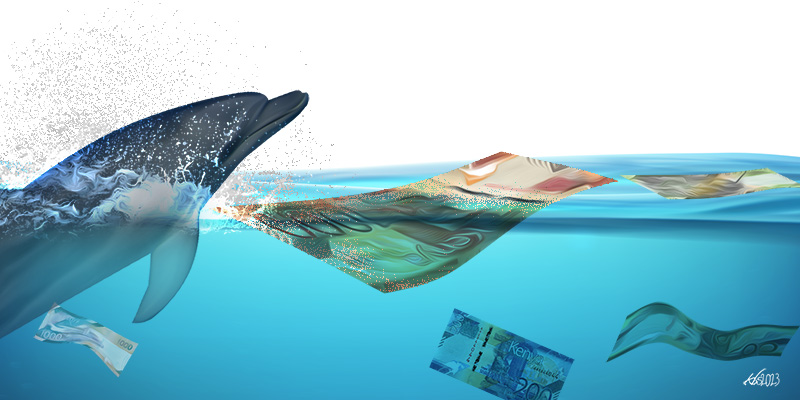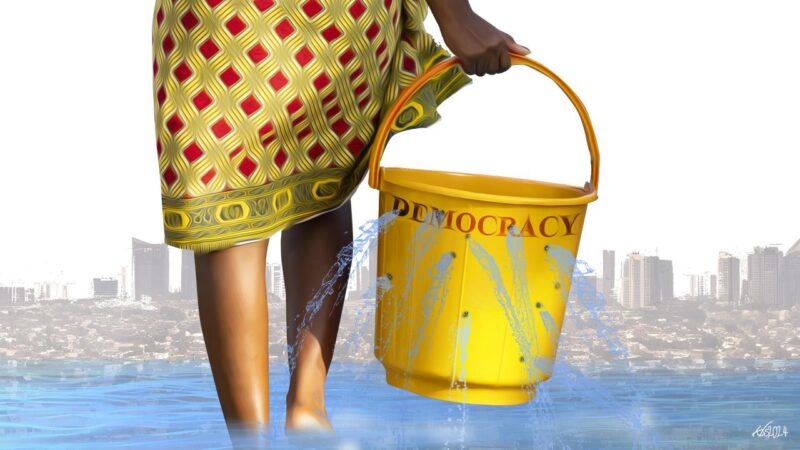The place of the maritime industry in accelerating economic growth in Kenya has been increasingly debated in recent years. However, not much has been done to create new jobs due to a lack of deliberate and sound policies that are matched with the necessary budgetary allocation to train a workforce in order to tap into what could arguably be the next frontier of economic development.
Even the Kenya Kwanza manifesto—which is detailed in other areas of the economy—is silent on how to awaken this sleeping giant. Moreover, the budget estimates for 2023/2024 only mention the blue economy in passing, giving it a paltry allocation. Two critical areas, which are closely related, have sealed the fate of this industry: failure to exploit the full commercial potential of the sector due to a lack of a properly trained workforce that is itself due to a lack of training capacity.
The weaknesses bedevilling the industry were identified when the State Department for Shipping and Maritime Affairs signed an agreement with the Higher Education Loans Board (HELB) to establish a Maritime Education and Training (MET) Financial Support Scheme in 2021 to support capacity building in the maritime and blue economy sector.
Amb. Nancy Karigithu, a former Director General of the Kenya Maritime Authority (KMA) and former Principal Secretary in the State Department for Shipping and Maritime, pointed out that there was a need for training funds to be made available in a more structured way in order for such opportunities to be more accessible for Kenyan Youth. Undertaking training abroad—as most skilled people working in the industry have done in the past years—is highly prohibitive in terms of cost.
Moreover, although a huge chunk of the country’s budget goes to the education sector, very little of it is absorbed by the maritime training institutions where huge infrastructural investments need to be made in order to train a competitive workforce. Such training institutions also require adequate space in which to install the equipment needed for the trainees, which must be adapted to the work environment to which they will eventually be deployed.
In a bid to address the issue of training, a policy decision was taken to establish Bandari College under the tutelage of the Kenya Ports Authority. It was later renamed Bandari Maritime Academy (BMA), gaining an independent status. Due to the slow pace at which maritime training has grown in the country, one of the biggest challenges facing BMA and other Technical and Vocational Education and Training (TVET) institutions that have rolled out maritime training courses is a lack of training personnel.
This is not just a Kenyan problem but a regional one. A stakeholders’ forum that convened on 7 October 2021 in Nairobi under the auspices of the Intergovernmental Standing Committee on Shipping (ISCOS—a regional maritime organisation for Kenya, Uganda, Tanzania and Zambia) to address the challenges in Maritime Education and Training (MET), returned a harsh verdict of a sector in dire need of reforms and significant government and regional support.
Industry stakeholders from ISCOS member states noted that the lack of qualified training staff and maritime professionals was a huge challenge that was holding back the growth of a critical sector of the economy. Inadequate and expensive training facilities, tools and equipment were also cited as a huge challenge that was hampering progress in the industry.
There is a global workforce shortage in seafaring, a key area that Kenya could tap into and create jobs in just a few years if deliberate efforts are made towards that end. This is low-hanging fruit for the Mombasa economy, which has witnessed dwindling economic opportunities since the Standard Gauge Railway (SGR) moved logistics to Nairobi. The proposed Special Economic Zone (SEZ) that could have offered alternative employment has been challenged and is facing litigation in the courts after environmentalists questioned its ability to deal with sea pollution.
Kenya’s success in the hospitality industry has seen shipping lines such as Mediterranean Shipping Company (MSC) recruit locals to work on their liners. But this is not the case on container, bulk and tanker ships because most Kenyan-trained seafarers lack the skills needed by crew working on these vessels.
The International Maritime Organisation (IMO)—where Amb. Karigithu is one of the candidates for election to the position of Secretary-General slated for 18 July this year—has developed a series of model courses that provide suggested syllabi, course timetables and learning objectives to assist the instructors to develop training programmes that meet the Standards of Training, Certification and Watchkeeping for Seafarers (SCTW) convention.
Of the more than 30 courses offered in maritime training, as recommended by the IMO, BMA was only able to offer six in 2021. In addition, the country lacks onboard training opportunities as Kenya does not have a training ship of its own. This has caused delays in the completion of training courses given that onboard training is compulsory to obtain certification. This is a problem facing other institutions providing maritime training such as Jomo Kenyatta University of Agriculture and Technology (JKUAT) which offers marine engineering courses. Training programmes must ensure that students acquire practical knowledge through actual work experience; trainees must learn by doing while at sea and in port.
Lack of training has also affected the exploitation of marine fishing since the country does not have the seafarers and equipment necessary to fully exploit the immense fish volume in the high seas. The International Convention on Standards of Training, Certification and Watchkeeping for Fishing Vessel Personnel, 1995 (STCW-F 1995), which came into force in 2012, sets certification and minimum training requirements for crews of seagoing fishing vessels of 24 metres and above in length.
Training programmes must ensure that students acquire practical knowledge through actual work experience.
Last year, the government drafted a set of regulations to empower industry players, which it said would double the fish catch to 300,000 metric tonnes. According to the Draft Marine Fisheries (Access and Development) Regulations 2022 and the Lake Turkana Fisheries Management Plan, Kenya has the potential to earn at least KSh100 billion and create 240,000 jobs annually once the new regulations are fully implemented.
Former Agriculture Cabinet Secretary Peter Munya last year said billions of people globally, especially the world’s poorest, rely on healthy oceans as a source of jobs and food nutrition. About 60 million people globally are employed in fishing and the oceans contribute about US$1.5 trillion annually to the overall global economy according to a 2022 World Bank report.
In Kenya, marine fisheries account for less than 10 per cent of the national fish landings and sustain the jobs of more than 1 million individuals whose income depends directly or indirectly on fishing, according to Munya. The number of fishers employed directly in Kenya’s marine sector is 13,426.
Kenya has an abundance of untapped potential in maritime resources along its marine coastline that extends over 650 kilometres, translating to a total area of 9,700 square kilometres of territorial waters and an Economic Exclusive Zone (EEZ) constituting a further 142, 400 square kilometres.
About 60 million people globally are employed in fishing and the oceans contribute about US$1.5 trillion annually to the overall global economy.
Optimal exploitation of marine fishing in Kenya is hindered by infrastructural limitations, inappropriate fishing craft and gear and a lack of properly trained seafarers. Artisanal fishers restrict their operations mainly to the continental shelf because they are ill-equipped in terms of craft and equipment to fish in the deep sea.
Despite its huge potential, the sector is underfunded. In this year’s budget, KSh3.5 billion went to the Kenya Marine Fisheries and Socio-Economic Development Project; KSh1.2 billion to Marine Fish Stock Assessment; KSh580 million to Capacity Building in Deep Sea Fishing; KSh142 million to rehabilitation of Fish Landing Sites in Lake Victoria; KSh141.5 million to Aquaculture Technology Development and Innovation Transfers; KSh500.7 million to Liwatoni Ultra-Modern Fish Hub and KSh88 million to the Development of Blue Economy Initiatives.
The deep-sea waters are left to the Distant Water Fishing Nations (DWFN) that mainly fish tuna species; Kenya lies within the rich tuna belt of the West Indian Ocean where 25 per cent of the world’s tuna is caught.
Foreign fishing fleets can operate in Kenya’s Exclusive Economic Zone (EEZ) through the regional and international agreement and cooperation provision of the National Oceans and Fisheries Policy, which allows governments to continue granting fishing rights in their EEZs based on the state of the stock and the economic returns.
Another critical area in which Kenya can exploit the blue economy is through the ownership of ships in partnership with already existing shipping lines. Former president Uhuru Kenyatta signed a controversial deal between the Kenya National Shipping Line Ltd (KSNL) and Mediterranean Shipping Company (MSC) with this objective in mind but the deal has not been actualized.
A recent promise by the Shipping and Maritime Affairs Permanent Secretary Shadrack Mwadime that the government would invoke the cabotage laws under the Merchant Shipping Act to allow and facilitate sea-borne transshipment is a good proposal that needs government support.
Kenya does not have a national shipping carrier. Transshipment, which involves the transfer of goods from one vessel to another for shipping to the final destination, is an opportunity that Kenyan ship owners could exploit. However, the country must remove the bottlenecks cited by shipping lines as a hindrance to using Mombasa port, particularly the customs procedures that make Mombasa unattractive as a transshipment hub.
In supporting the deal signed between KNSL and MSC, the government estimated that its cargo imports cost an average of KSh14 billion in freight per year, while local destination charges by shipping lines comprise another KSh34 billion. With local shipping capacity and the application of “Buy Kenya, Build Kenya” policies, the amount of freight charges of KSh14 billion could be retained in Kenya.
In the absence of a pricing framework or a competitive environment, the Mombasa port tariff for shipping lines has proliferated to 36 charge items. The revived KNSL, the government observed, could be used by the government to influence and leverage the reduction or elimination of components of destination charges thus reducing the national burden in the maritime transport of government cargo. The charges include delivery order fees, amendment to the bill of lading fees, supervision fees, manifest correction fees, currency exchange rates, container repair charges, and equipment management fees, among others.
In running the liner service, KNSL had the option of chartering or acquiring its own vessels over time. It was anticipated that income arising from transferring MSC transshipment cargo from Mombasa to other ports around Africa would yield sufficient funds to make vessel acquisition a reality in the long run.
Kenya can draw vital lessons from the Ethiopian Shipping and Logistics Service Enterprise (ESLSE). By 2020, when ESLSE was planning to acquire two more vessels, it had 11 ships with a total loading capacity of 400,000 tons of cargo.
Transshipment, which involves the transfer of goods from one vessel to another for shipping to the final destination, is an opportunity that Kenyan ship owners could exploit.
Marine Cargo Insurance (MCI) also has huge potential, if the government puts in place strong measures to enforce it. Its overall performance has significantly improved since the National Treasury’s directive to enforce Section 20 of the Insurance Act came into effect on 1 January 2017, which requires compulsory purchase of MCI from local underwriters.
However, importing cargo on Cost Insurance Freight (CIF) and the lack of proper coordination between the various agencies has made enforcing this requirement a huge challenge.
Claims of undercutting have been cited in the MCI insurance business as a record number of players have entered the segment. The Insurance Regulatory Authority (IRA) had in the past raised concerns over unsustainable premiums.
Following the directive, however, the MCI has performed considerably well compared to the years before 2017. The gross written premiums were KSh2.3 billion compared to KSh1.45 billion in 2016, representing an increase of 59 per cent. Based on the value of the imports, MCI premiums can generate up to KSh20 billion annually, according to ISCOS.
However, there is a silver lining on the horizon. Insurance companies are being brought onto the online cargo clearing system that is operated by KenTrade, which is being integrated with the Kenya Revenue Authority’s (KRA) Integrated Custom Management System (iCMS). This could help in enforcing section 20 of the Insurance Act.
If the government rhymes its rhetoric with policy and budgetary support, harmonizes the activities of the 22 agencies running the industry that have conflicting roles, and focuses on maritime training and education, the blue economy has tremendous potential to propel Kenya to great economic heights.








